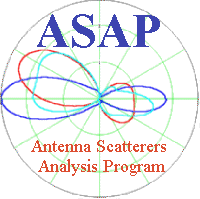

A simple J-pole antenna was studied to get an idea of the extent that changes in feedline length (or conducting support structure) would make on the pattern. Also the feedpoint was moved to get an idea of its effect on pattern.
Since this is a summary of results no details will be given about the J-pole. The results, although "exact" for the particular J-pole studied, should only be viewed as a qualitative concept for J-poles in general. The point of this page is to show that the feedline and feedpoint are extremely important to the performance of the J-pole.

In this summary, 3 feedpoints and one support length will be given. In the figure above, feedpoint A is in the center of the half-wave "radiating" element, feedpoint B is in the exact center of the bottom of the 'U' section at the bottom, and feedpoint C is across the 'U' in the matter normally shown in the books for matching the J-pole to the feedline.
Only one length of electrically conductive support, a quarter-wave long, is used although two cases for this support are shown. One case is with the support electrically connected to the rest of the antenna; the other case is with the quarter-wave long support electrically isolated from the antenna (as though some sort of perfect RF current isolater/balun was used). The bottom end of the support is in free space (not grounded to a ground-plane).
| Max Gain dB | Angle Above (+) or Below (-) Horizon for Max Gain | Gain at Horizon | Impedance Ohms | ||
|---|---|---|---|---|---|
| Feedpoint A, Support Connected | 2.68 | -33 | -- | 88.87 + j46.5 | |
| Feedpoint B, Support Connected | 4 | +1 | 3.97 | 30.87 + j86.56 | |
| Feedpoint C, Support Connected | 2.19 | +79.4 | 1.31 | 340.71 - j912.2 | |
| Feedpoint A, Support Disconnected | 2.67 | +1 | 2.66 | 171 + j127.8 | |
| Feedpoint B, Support Disconnected | 3.31 | +29 | 2.33 | 42.3 + j97.87 | |
| Feedpoint C, Support Disconnected | 2.95 | +30 | 2.07 | 327.9 -j962 | |
As can be seen, the maximum gain is rarely at the horizon. Once again it is emphasized that the results shown are only for one particular length of support structure. The results vary greatly with changes to the length of the support structure.
The study that has been made of the J-Pole illustrates that the 'J' matching section does not prevent antenna current from flowing on the support structure (if conducting) or the feedline. The support/feedline therefore become part of the antenna. The J-Pole antenna shown above is really a full wave structure when the support is connected. With the support disconnected the structure is a 3/4 wave antenna system.
Antennas that are over one-half wave long frequently have patterns that are sensitive to the feedpoint position and frequency. On the other hand, the radiation patterns of a half-wave or shortened dipoles are not materially affected by feedpoint or frequency changes (although the impedance will vary considerably).
Although it is not shown in this summary, the above structure also shows a fair amount of sensitivity to changing the frequency.
Conclusions:
J-Poles as typically implemented with moderately long feedlines (in terms of wavelength) may actually be acting as multi-wavelength long antenna with the feedpoint near one end. These cases have been modeled (but are not shown in this summary). Such antennas can have multiple lobes in unusual directions. As a result, a particular J-Pole antenna implementation (or any antenna with a long feedline) may not act as presented in the technical liturature. Some form of current choke/balun may need to be employed on the feedline. The 'J' structure does not provide the "choke" action needed. One the other hand, if the geometry and feedline length can be precisely controlled, the patterns resulting from this multi-wavelength effect might be used to advantage.
Back to: Examples Index Page
Including:
See also the quick reference for the user's guide.
Goto Systems Manual
(Theory of Operation)
Return to ASAP Homepage
Last modified on: 3 Nov 2007